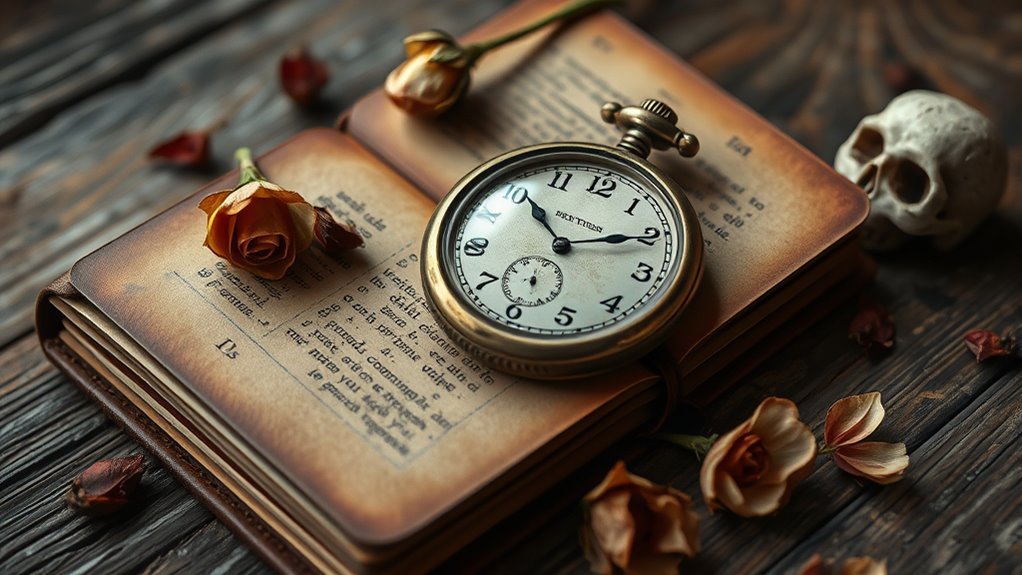By embracing memento mori, you acknowledge life’s impermanence, which encourages you to reflect on your true values and live intentionally. Symbols like skulls, hourglasses, and meaningful rituals serve as reminders to prioritize what matters most. Recognizing mortality deepens your purpose, fosters humility, and inspires authentic actions. To explore how these principles can transform your life and help you find deeper meaning, discover more about integrating this ancient wisdom into your daily journey.
Key Takeaways
- Reflecting on mortality fosters clarity about personal values and life goals, guiding authentic and purpose-driven decisions.
- Symbols of Memento Mori serve as visual reminders to prioritize meaningful pursuits over trivial concerns.
- Embracing the impermanence of life encourages mindfulness and gratitude, enriching life’s purpose and fulfillment.
- Philosophical insights from Stoicism and other traditions promote living virtuously in awareness of life’s fleeting nature.
- Personal rituals and artistic expressions deepen self-awareness and reinforce commitment to living intentionally.
The Origins and Significance of Remembering Death

Remembering death has deep roots in ancient philosophies and spiritual traditions, serving as a powerful reminder of life’s impermanence. Throughout history, symbolic art and cultural practices have conveyed this awareness through artistic representations like skulls, hourglasses, and wilting flowers. These visual symbols, found in Vanitas paintings and Roman triumphs, highlight mortality’s universal presence. They encourage humility and reflection, urging you to recognize life’s fleeting nature. By engaging with these historical symbols, you connect with a timeless tradition that emphasizes humility and purpose. Embracing this symbolism can inspire you to live intentionally, understanding that mortality is a shared, enduring aspect of human experience. Remembering death reminds us to prioritize what truly matters and to cherish each moment we have. Recognizing the impermanent nature of life can deepen your appreciation for everyday experiences and motivate you to live more meaningfully. Additionally, understanding the cultural significance of these symbols enhances their power to foster mindfulness. Exploring symbolic representations can further deepen your understanding of mortality’s role in shaping human consciousness, especially when considering the historical context behind these enduring motifs.
Philosophical Insights on Mortality and Living Virtuously

Philosophers have long regarded mortality as a vital catalyst for living a meaningful and virtuous life. Death awareness prompts deep philosophical reflection, encouraging you to examine your values and actions. By contemplating mortality, you recognize life’s impermanence, inspiring you to prioritize virtue over trivial pursuits. Stoics like Marcus Aurelius and Seneca teach that accepting death fosters humility, gratitude, and moral integrity. Embracing mortality as a guiding principle helps you live intentionally, focusing on what truly matters. Additionally, understanding regional divorce statistics can serve as a reminder of life’s uncertainties and the importance of living purposefully. Recognizing the diversity of natural environments in places like New England can inspire appreciation for life’s fleeting beauty. Exploring cultural differences related to mortality can deepen your understanding of how different societies approach life and death, enriching your perspective. Moreover, exploring existential themes can lead to a more profound grasp of human mortality and our shared vulnerability. Furthermore, advancements in AI Security highlight the importance of safeguarding our digital lives to ensure a secure future. Ultimately, understanding your mortality transforms how you approach each day, aligning your life with purpose and virtue.
Practical Ways to Incorporate Memento Mori Into Daily Life

Incorporating memento mori into your daily routine can considerably shift your perspective on life’s priorities. To do this, try these practical steps:
- Practice meditative journaling, reflecting on mortality and gratitude each morning. Incorporating mindfulness practices can deepen your awareness of life’s transient nature. Engaging in visualization techniques during journaling can help create vivid mental images that reinforce the impermanence of life. Exploring concepts of impermanence can further enhance your understanding of life’s fleeting quality.
- Establish mindful rituals, like pausing before meals or sleep to contemplate life’s fleeting nature.
- Use a tangible reminder, such as a medallion or symbolic object, during daily challenges.
- Incorporate brief moments of silent reflection during junctures, reminding yourself of mortality’s presence.
- Educate yourself about prophetic dreams and their significance, which can deepen your understanding of life’s spiritual dimensions and reinforce the importance of living purposefully.
Modern Tools and Symbols to Remind Us of Life’s Fragility

Modern tools and symbols have emerged as accessible ways to keep the awareness of life’s fragility alive in everyday life. Symbolic jewelry, like skull or hourglass pendants, serve as personal reminders during daily routines. Death-themed art, including minimalist sculptures or paintings featuring skulls and flowers, evoke reflection on mortality. These symbols foster mindfulness and humility, grounding you in life’s impermanence.
| Symbolic Jewelry | Death-Themed Art |
|---|---|
| Skull pendants | Vanitas paintings |
| Hourglass charms | Mortality sculptures |
| Cross or ring motifs | Memento Mori installations |
Personal Expressions and Cultural Adaptations of Memento Mori

Personal expressions of Memento Mori have evolved beyond traditional symbols to reflect individual beliefs and cultural identities. You might choose symbolic tattoos, like skulls or hourglasses, to serve as permanent reminders of mortality and personal philosophy. Cultural rituals also adapt Memento Mori, such as funeral rites or celebrations honoring ancestors, emphasizing life’s fleeting nature. These adaptations deepen your connection to mortality, inspiring authentic living. Additionally, fragrance oils can be incorporated into personal rituals or memorials to evoke reflection and remembrance. Incorporating cultural practices enhances the personal significance of these expressions, allowing for a richer connection to mortality. Here are some ways people express this concept:
- Symbolic tattoos representing death or humility
- Cultural rituals emphasizing remembrance and humility
- Artistic work inspired by Memento Mori themes
- Personal meditations or affirmations rooted in mortality awareness
How Reflecting on Mortality Fosters Purpose and Perspective

Reflecting on mortality sharpens your sense of purpose and shifts your perspective on what truly matters. It encourages mindfulness meditation, helping you stay present and appreciate each moment. By contemplating life’s impermanence, you’re motivated to plan your legacy intentionally. Use this awareness to prioritize meaningful relationships and goals over trivial pursuits. Considering the cybersecurity vulnerabilities associated with digital life can also strengthen your resolve to protect your personal information and digital assets. This practice fosters clarity, purpose, and a deeper understanding of life’s fleeting nature. Engaging with the Law of Attraction principles can further amplify your awareness and motivation to create a meaningful life. Recognizing the enduring impact of Bollywood legends can inspire you to pursue a lasting legacy through your passions. Additionally, exploring spiritual principles can deepen your understanding of life’s transient nature and guide your journey toward fulfillment. Embracing emotional support techniques can help you navigate the emotional challenges that come with reflecting on mortality and purpose.
Embracing Mortality to Live a More Meaningful and Authentic Life

When you accept the reality of mortality, you open the door to living more intentionally and authentically. Embracing death helps you confront ethical dilemmas with clarity, prioritize what truly matters, and consider societal implications of your actions. To deepen this perspective:
- Reflect daily on life’s impermanence to inspire genuine choices.
- Use symbols like skulls or hourglasses as reminders of mortality.
- Acknowledge how societal norms influence your view of death and purpose.
- Consider ethical dilemmas as opportunities to align actions with your authentic values.
- Recognize that understanding impermanence can influence how you approach intimacy and relationships in your life.
Frequently Asked Questions
How Can Practicing Memento Mori Improve Mental Health and Emotional Resilience?
Practicing memento mori boosts your mental health and emotional resilience by encouraging mindfulness meditation and gratitude journaling. When you reflect on mortality, you become more present and appreciative of life’s fleeting moments. This awareness helps you manage stress, reduces fear of death, and fosters gratitude for what you have. Over time, these practices strengthen your emotional resilience, making you more adaptable and centered during life’s challenges.
What Are Some Common Misconceptions About the Practice of Remembering Mortality?
Some think remembering mortality amplifies fear, but it actually fosters perspective. Cultural misinterpretations often portray memento mori as morbid or depressing, when it’s meant to inspire humility and purpose. You might believe it’s about dwelling on death, but instead, it encourages you to live fully and intentionally. Don’t let misconceptions like fear amplification or negative stereotypes prevent you from embracing this timeless practice that can deepen your appreciation for life.
Is There a Recommended Age or Stage in Life to Start Contemplating Death?
If you think contemplating death is only for the old, think again—there’s no better time than now! Age appropriateness varies, but starting early can shape your perspective. Cultural timing matters too, as different traditions embrace mortality at different stages. You don’t need to wait for a milestone; the sooner you reflect, the more you’ll appreciate life’s fleeting beauty and live intentionally, no matter your age.
Can Memento Mori Be Tailored for Different Cultural or Spiritual Beliefs?
You can tailor memento mori to fit your cultural adaptations and spiritual variations by emphasizing symbols and practices meaningful to your beliefs. For example, in some cultures, like Buddhist traditions, meditation on death aligns with mindfulness, while others incorporate specific rituals or art. Adjusting the practice allows you to connect more deeply, making it a personal reminder of mortality that resonates with your values and spiritual perspective.
How Do I Overcome Fear or Anxiety Associated With Contemplating Mortality?
Imagine standing at the edge of a cliff, feeling fear and anxiety rise. To reduce fear and manage anxiety, embrace mortality with gentle acceptance, not avoidance. You can practice mindfulness, focusing on the present moment, and remind yourself that contemplating death fosters gratitude and perspective. This shift transforms fear into motivation, helping you face life’s uncertainties with courage, clarity, and a deeper appreciation for each moment.
Conclusion
By embracing Memento Mori, you tap into a timeless truth: our mortality sharpens your focus and fuels your purpose. Research suggests that contemplating death can increase gratitude and life satisfaction, aligning with theories of existential psychology. When you acknowledge life’s fleeting nature, you’re more likely to live authentically and prioritize what truly matters. Ultimately, facing mortality isn’t about fear—it’s about releasing a deeper, more meaningful connection to your own life.









